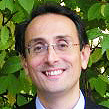The session focuses on conversion systems for wind turbines based on power electronics, mainly for off-shore applications. The trend of higher power brings several challenges related to compliance with grid requirements. Harmonics and resonances become crucial issues that require proper analysis and innovative yet practical solutions. This session covers aspects related to power converter architectures and the modulation and control of the converter. We will look at the interaction with the electrical grid as well as practical aspects about how to optimise the primary control in different wind conditions and how to effectively test the control of large-scale wind systems in emulated conditions.
You attended this session?
Learning objectives
- To explain a number of ways that the different power converter systems (including their filter) impact the real operation of an offshore wind park;
- To identify the value of grid emulator test benches;
- To list possible advantages of frequency converters in wind energy;
- To explore methods that lead to reducing the cost reductions of integrating offshore wind energy.


Presenter

Co-authors:
Stephan Ebner (1) F
(1) ABB Switzerland Ltd, Turgi, Switzerland (2) ABB Switzerland Ltd, Turgi, Switzerland
Presenter's biography
Biographies are supplied directly by presenters at WindEurope Summit 2016 and are published here uneditedMr. Stephan Ebner has been working at ABB Switzerland in different roles in power electronics for more than 20 years. He is currently head of product management and quality for medium-voltage converters into the wind and tidal industry. Since 2008 he is involved in development, sales, engineering and service of the PCS6000 frequency converter with many onshore- and offshore wind turbine manufacturers worldwide. The key experience is related to converter installation and operation at the German offshore wind parks BorkumWest2 and GlobalTech1. His motivation is to deliver a first class converter product with unique features for a bright future of the wind industry.
Abstract
Frequency converters in wind turbines – a technical boon or bane? An introduction to a state-of-the-art converter technology as used in large offshore wind turbines
Introduction
I. INTRODUCTION
A distributed power generation with many turbines like in an offshore wind farm requires a well-coordinated design of the wind turbine’s electrical drivetrain components, the collection grid and the substation. This paper describes how to overcome and avoid harmonic resonance problems by using a state-of-the-art frequency converter design for a trouble-free operation of the collection grid and the substation.
Further the paper explains how apart from the basic function of frequency conversion a state-of-the-art frequency converter improves the wind turbine productivity, handling and operational cost and hence how it contributes to reduce the Levelized Cost of Energy (LCOE) for offshore wind.
Approach
II. APPROACH
By newly introduced converter features the risk for instability of the wind park collection grid gets significantly reduced. The explained features are:
- Filterless-design of the converter grid-side
- Choosing the ideal pulse pattern by OPP
- Verification of passive converter behavior along the
full grid spectra
Main body of abstract
III. SOLUTION
A wind park collection grid is a complex mesh of cable strings with many possible different constellations of connected or disconnected strings and turbines. Each constellation must stay within the limits for impedance and especially its resonance profiles and therefore every wind farm development will go through a detailed wind park system study.
Resonance points along the wind park short circuit diagram can create serious problem when falling across with stimulating harmonic e.g. coming from the wind turbine converter. In the case, countermeasures require a flexible converter design, e.g. most useful with a flexible pulse pattern generation.
a) Latest converter technologies allow a grid-side filterless design, with the benefit of eliminating an additional pole into the system impedance. This clearly improves the robustness of the wind park system and as least important, improves the LCOE with lower CAPEX cost plus a better system efficiency for a higher energy production.
b) Consequently a measure must ensure that without having a harmonic filter anymore the harmonic level as defined in the grid codes are within the given limits. To achieve this the modulation principle of ‘Optimized Pulse Pattern’ (OPP) is used. When using OPP it is possible to distribute harmonics freely across the spectra in such a way that the amplitude is within the limits of the grid code and no harmonics are located in critical areas of grid resonance points.
c) In all cases the converter itself shall stay as a passive element for harmonics coming from outside and never itself come to resonance and amplifying harmonics.
Conclusion
IV. CONCLUSION
Converters having a filterless design, the modulation principle of Optimized Pulse Pattern and Harmonic Resonance Prevention avoid collection grid disturbances.
Such converter designs allow much more flexibility by software pulse pattern adaption to eliminate detected problem within the existing installation.
Learning objectives
V. LEARNINGS
Stability and trouble-free operation of an offshore wind park collection grid gets enhanced by using state-of-the art converter design.
a) A converter design without using the hardware of a grid-side L-C-L filter are significantly reducing the complexity of the collection grid design and its behavior and improve the system efficiency.
b) Using the Optimized Pulse Pattern method gives the freedom to locate harmonics in the frequency spectra freely controllable. Herby critical spectra area can be avoided by shifting of harmonics.
c) State-of-the-art converters stay passive along the spectra frequency range and don’t do amplification of grid harmonics and resonances.







Follow EWEA on: